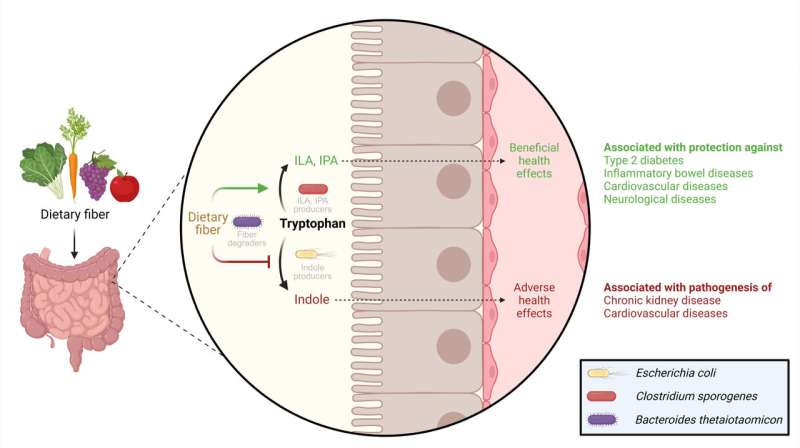
Tryptophan, an essential amino acid, is transformed in the large intestine into beneficial or harmful substances. Research shows that tryptophan contributes to the production of the healthy substances indole lactic acid (ILA) and indole propionic acid (IPA) when we consume sufficient amounts of dietary fiber. However, if we do not consume enough dietary fiber, tryptophan will be transformed into indole, a substance associated with adverse health effects. The figure is created with BioRender (biorender.com) by Martin Frederik Laursen. Credit: The figure is created with BioRender (biorender.com) by Martin Frederik Laursen.
We get healthy dietary fiber by consuming fruits, vegetables and whole grains. But why is fiber so good for us? A team of researchers has discovered that dietary fiber plays a crucial role in determining the balance between the production of healthy and harmful substances by influencing the behavior of bacteria in the colon.
Dietary fiber is beneficial for our health, and scientists from DTU’s National Food Institute and the University of Copenhagen’s Department of Nutrition, Exercise and Sport have now discovered a key part of the reason why. which is the case. Different types of bacteria inside our colon compete to use an essential amino acid called tryptophan. This competition can have positive or negative consequences on our health.
The research, published in the journal Natural microbiology, reveals that when we eat a lot of dietary fiber, gut bacteria help break down tryptophan into healthy substances. But if we don’t eat enough fiber, tryptophan can be converted into harmful compounds by our gut bacteria.
“These findings highlight that our dietary habits significantly influence the behavior of gut bacteria, creating a delicate balance between health-promoting activities and those associated with disease. In the long term, the findings may help us design dietary programs that prevent a whole range of diseases,” says Tine Rask Licht, professor at the DTU National Food Institute.
Dietary fiber determines the battle against tryptophan
Researchers have long known that dietary fiber is directly converted into healthy short-chain fatty acids by intestinal bacteria in the colon. However, the new study surprisingly shows that dietary fiber also contributes to good health by preventing the conversion of the amino acid tryptophan into harmful substances and promoting its conversion into beneficial substances in the colon.
“The gut bacteria E. coli can convert tryptophan into a harmful compound called indole, which is associated with the progression of chronic kidney disease. But another gut bacteria, C. sporogenes, converts tryptophan into healthy substances associated with protection against kidney disease. inflammatory bowel diseases”, type 2 diabetes, cardiovascular diseases and neurological diseases”, explains Anurag Kumar Sinha, researcher at the DTU National Food Institute.
Through multiple experiments in bacterial cultures and mice, researchers demonstrated that fiber-degrading gut bacteria, such as B. thetaiotaomicron, regulate the indole-forming activity of E. coli. coli.
“B. thetaiotaomicron helps by breaking down fiber into simple sugars, which E. coli prefers over tryptophan for growth. The sugary components of fiber prevent E. coli from converting tryptophan into indole, allowing C. sporogenes to use the tryptophan to produce healthy compounds,” explains Anurag Kumar Sinha.
Understanding the behavior of gut bacteria
It is well known that dietary fiber can change the composition and quantity of bacteria in our gut microbiome. However, simply looking at the composition and abundance of gut microbial species will not tell us much about their impact on our health.
“The field of gut microbiome research has focused heavily on assessing the effects of, for example, diet on the amount of potentially good or bad gut bacteria, but often overlooks the fact that diet can regulate the activity of gut bacteria without necessarily making major changes to the number of gut bacteria species in the colon,” explains Martin Frederik Laursen, associate professor at the DTU National Food Institute.
Thus, dietary fiber not only helps change the types of bacteria present in the gut, leading to a healthier composition, but also influences the behavior of gut bacteria in ways that promote health.
“As a research community, we need to stop thinking of gut bacteria and their abundance as strictly good or bad, but rather understand how we make our gut bacteria behave well or badly,” says Martin Frederik Laursen.
This understanding can help scientists develop better dietary recommendations that keep our gut healthy and prevent disease.
Essential amino acids, such as tryptophan, must be obtained through food since the body cannot synthesize them. Protein-rich foods are sources of tryptophan. Examples include chicken, turkey, salmon, tuna, eggs, milk, cheese, yogurt, legumes, nuts and seeds. Dietary fiber is found in fruits, vegetables and whole grains.
More information:
Dietary fiber directs microbial tryptophan metabolism via metabolic interactions in the gut microbiota, Natural microbiology (2024). DOI: 10.1038/s41564-024-01737-3. www.nature.com/articles/s41564-024-01737-3
Provided by the Technical University of Denmark
Quote: Dietary fiber regulates the use of tryptophan by intestinal bacteria, which impacts health (June 25, 2024) retrieved June 25, 2024 from https://medicalxpress.com/news/2024-06-dietary- fiber-gut-bacteria-tryptophan.html
This document is subject to copyright. Except for fair use for private study or research purposes, no part may be reproduced without written permission. The content is provided for information only.